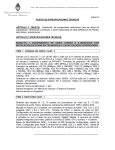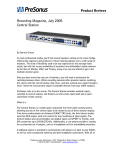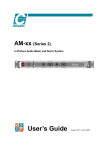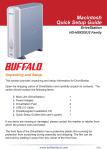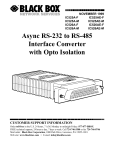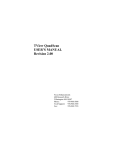Download Marshall Electronics AR-DM2X-X Specifications
Transcript
Marshall Electronics Warranty Marshall Electronics warranties to the first consumer that this AR-DM2X-X Audio Monitor will, under normal use, be free from defects in workmanship and materials, when received in its original container, for a period of one year from the purchase date. This warranty is extended to the first consumer only, and proof of purchase is necessary to honor the warranty. If there is no proof of purchase provided with a warranty claim, Marshall Electronics reserves the right not to honor the warranty set forth above. Therefore, labor and parts may be charged to the consumer. This warranty does not apply to the product exterior or cosmetics. Misuse, abnormal handling, alterations or modifications in design or construction void this warranty. No sales personnel of the seller or any other person is authorized to make any warranties other than those described above, or to extend the duration of any warranties on behalf of Marshall Electronics, beyond the time period described above. Due to constant effort to improve products and product features, specifications may change without notice. AR-DM2X-X Digital Audio Monitor with Dolby™ / Dolby E™ Capability Operating Instructions Marshall Electronics, Inc. 1910 East Maple Ave. El Segundo, CA 90245 Tel: (800) 800-6608 / (310) 333-0606 • Fax: 310-333-0688 www.LCDRacks.com • [email protected] 24 v1.0 Specifications (continued) Input / Output Modules ■ ARDM-HDSDI Input Module Inputs: Outputs: SDI Formats: SDI Standards: Audio Coding: Sample Rates: 1 x SDI (75Ω BNC) – 16 channels embedded audio 1 x SDI Equalized Loop-Through (75Ω BNC) 525i, 625i, 720p, 1080i, 1080p SMPTE 259M, 292M, 274M, 296M, 260M PCM, DOLBY E, DOLBY DIGITAL (AC-3) 44.1kHz, 48kHz ■ ARDM-AES-BNC Input Module Inputs: Outputs: Formats: Audio Coding: Sample Rates: 4 x AES/EBU (Unbalanced 75Ω BNC) 4 x AES/EBU (Unbalanced 75Ω BNC) Passive Loop-Through Professional and Consumer (SPDIF) PCM, DOLBY E, DOLBY DIGITAL (AC-3) 44.1kHz, 48kHz ■ ARDM-AES-XLR Input Module Inputs: Outputs: Formats: Audio Coding: Sample Rates: DB-25 Pinout: 4 x AES/EBU (Balanced 110Ω XLR-F, via DB-25 Connector) 4 x AES/EBU (Balanced 110Ω XLR-M via DB-25 Connector) Passive Loop-Through Professional and Consumer (SPDIF) PCM, DOLBY E, DOLBY DIGITAL (AC-3) 44.1kHz, 48kHz “Tascam” Standard Pinout (Mogami GOLD-AES-TD-DB25-XLR-05 Break-Out Cable Included) ■ ARDM-AA-8XLR Input Module Inputs: Reference: DB-25 Pinout: 8 x Analog (Balanced XLR-F via DB-25 Connector) 0, 4, 6, or 8dBu = -20dBFS (Selectable) Mogami GOLD-DB25-XLR-05 Break-Out Cable Included ■ ARDM-AES-4OUT Output Module Outputs: Formats: Audio Coding: Sample Rates: 4 x AES/EBU (Unbalanced 75Ω BNC) Professional and Consumer (SPDIF) PCM, DOLBY E, DOLBY DIGITAL (AC-3) 44.1kHz, 48kHz ■ ARDM-AA-2OUT Output Module Outputs: Reference: 2 2 x Analog (Balanced XLR) -20dBFS = 8dBu 23 Intentionally Left Blank Specifications AR-DM2X-X Audio Monitor ■ METERS AR-DM2-1 Meter Type: 16 x 1 LED Signal Presence Indicators Meter Dynamics: Not Available AR-DM21-B Meter Type: 16 x 10 Segment LED Bar Graph Meter Dynamics: Simultaneous VU & PPM (True Peak) Meter Scale: 0 to -66dB AR-DM22-B Meter Type: 16 x 20 Segment LED Bar Graph Meter Dynamics: Simultaneous VU & PPM (True Peak) Meter Scale: 0 to -66dB ■ ACOUSTIC AR-DM2-1 / AR-DM21-B Speaker Power Output: Left/Right RMS @ 4Ω: 10W, 14W Peak Peak Acoustic Output: 100dB SPL Headphone Power Output: 150 mW AR-DM22-B Speaker Power Output: Left/Right RMS @ 4Ω: 10W, 14W Peak Woofer RMS @ 4Ω: 25W, 35W Peak 22 Peak Acoustic Output: Headphone Power Output: 104dB SPL 150 mW ■ ELECTRICAL AR-DM2-1, AR-DM21-B Power Consumption: Voltage Requirement: Less than 45W 12-24 VDC AR-DM22-B Power Consumption: Voltage Requirement: Less than 45W 100VAC-230VAC ■ MECHANICAL AR-DM2-1 Rack Height: Weight (w/o modules): 1 RU 3.7 lbs. AR-DM21-B Rack Height: Weight (w/o modules): 1 RU 3.7 lbs. AR-DM22-B Rack Height: Weight (w/o modules): 2 RU 8.85 lbs. 3 Module Installation (continued) Intentionally Left Blank DOLBY Module Installation (continued) 4. After removing the top panel of the audio monitor, locate the DOLBY module slot labeled J12 on the main board. 5. Insert the ARDM-D552 module into slot J12 at a 45° angle to the main board. Ensure that the board is correctly oriented (The largest components on the module should be facing up). 6. Slowly push the module down so that it is parallel to the main board. Two metal brackets on either side of the slot will snap into place over the edges of the module, holding it place. If the module does not move downwards, check the orientation of the board to make sure it is not upside down. Do not force the module into place if it does not move easily. 7. To remove the module, push aside the metal brackets on each side of the slot so that the module is release upward. 8. Close the AR-DM2X-X Audio Monitor by re-fastening the 14 screws on the top panel. 4 21 Module Installation (continued) DOLBY Module Installation IMPORTANT: The following procedure involves exposing and handling bare electronic components. Proper anti-static precaution must be taken before opening the AR-DM2X-X Audio Monitor to avoid damage during installation. This includes working on a static-free surface and wearing a grounded wrist-strap or another type of grounding device. Opening the AR-DM2X-X Audio Monitor without proper anti-static precaution may void the warranty. For further information, contact Marshall Electronics. Use the following instructions to install the ARDM-D552 module in the AR-DM2X-X Audio Monitor. 1. Ensure that power is disconnected from the audio monitor. Contents Product Overview.................................................................................................................................................................. 6 Features ................................................................................................................................................................................. 6 Installation and Initial Setup ................................................................................................................................................ 7 Unpacking ........................................................................................................................................................ 7 Input / Output Module Installation............................................................................................................. 7 Audio Monitor Mounting .............................................................................................................................. 7 Quick Start Guide .................................................................................................................................................................. 8 Front Panel Features ............................................................................................................................................................ 9 Rear Panel Features............................................................................................................................................................ 10 Basic Operation................................................................................................................................................................... 11 Overview......................................................................................................................................................... 11 Selecting an Input Module ......................................................................................................................... 11 LED Bar Graph.............................................................................................................................................. 11 Audio Monitoring ......................................................................................................................................... 12 Monitor Modes .............................................................................................................................................................................. 12 Channel-Assign Indicator LEDs .................................................................................................................................................. 12 2. Disconnect all inputs and outputs. Headphone Output ad Audio Adjustments ........................................................................................... 13 3. Remove the top panel of the audio monitor by removing the 14 Phillips-head screws shown in the following diagram: Headphone Output........................................................................................................................................................................ 13 Volume Control ............................................................................................................................................................................. 13 Balance Control ............................................................................................................................................................................ 13 Mute Functions ............................................................................................................................................................................. 13 Reset Functions ............................................................................................................................................................................ 13 Dolby-Encoded Signals ...................................................................................................................................................... 14 Dolby Signal Indication .............................................................................................................................. 14 Decoding and Monitoring Dolby Signals............................................................................................... 14 Introduction................................................................................................................................................................................... 14 Entering Dolby-Decoding Mode................................................................................................................................................... 14 Downmixing Dolby-Decoded Audio ............................................................................................................................................ 14 Dolby Downmix Configurations ............................................................................................................... 15 LKFS Monitoring ................................................................................................................................................................. 16 Introduction ..................................................................................................................................................................................... 16 Setting up LKFS Monitoring ............................................................................................................................................................ 16 Remove 14 screws (circled) to open the top panel. Optional Modules ................................................................................................................................................................ 17 Input Modules ............................................................................................................................................... 17 ARDM-AES-BNC............................................................................................................................................................................ 17 ARDM-AES-XLR ............................................................................................................................................................................ 17 ARDM-HDSDI................................................................................................................................................................................. 17 ARDM-AA-8XLR ............................................................................................................................................................................ 17 Output Modules ............................................................................................................................................ 18 ARDM-AES-4OUT.......................................................................................................................................................................... 18 ARDM-AA-2OUT ............................................................................................................................................................................ 18 Dolby Module ................................................................................................................................................ 18 ARDM-D552 ................................................................................................................................................................................... 18 Module Installation.............................................................................................................................................................. 19 Input / Output Module Installation........................................................................................................... 19 Dolby Module Installation .......................................................................................................................... 20 Specifications ...................................................................................................................................................................... 22 AR-DM1-B Audio Monitor........................................................................................................................... 22 Input / Output Modules ............................................................................................................................... 23 Warranty............................................................................................................................................................................... 24 20 5 Product Overview Module Installation The AR-DM2X-X series is a 16-channel digital audio monitoring system, featuring tri-color LED bar graphs on certain models. Designed for ultra-near field audio monitoring in space critical environments, the AR-DM2X-X series is ideal for TV facilities, studios, post-production facilities, VTR bays, mobile production vehicles, satellite links, and wherever multichannel audio monitoring is required. Input / Output Module Installation The AR-DM2X-X series features stereo loudspeakers in compact 1RU or 2RU form factors, with Class D Amplification and 100% digital processing providing pristine audio quality. Interchangeable input and output modules provide unrivaled flexibility – up to four I/O modules can be installed in a single AR-DM2X-X audio monitor, each module with up to 16 channel inputs, providing a possible 64 channels per audio monitor. Input choices include balanced/unbalanced ® AES/EBU, SDI video with embedded audio, and balanced analog audio. With an optional DOLBY module, the AR® ® DM2X-X supports decoding and monitoring of DOLBY E and DOLBY DIGITAL (AC-3) signals, with the option to output discrete decoded channels or pass through encoded bit streams. Flexible monitoring modes include mono, stereo, and various stereo downmix configurations for multi-channel audio. Additional features include volume and balance controls, a headphone jack, and a USB port for on-site firmware upgrades. The ARDM-series input and output modules are designed for simple installation and removal without tools. Use the following instructions to install a module: 1. Ensure that the audio monitor is powered off. Modules cannot be installed or “hot swapped” while the audio monitor is powered on. 2. Remove the blank cover if present over the empty slot using a Philips screwdriver with appropriate head size. 3. Carefully slide the module into the open slot, aligning the side edges of the module with the guides inside the monitor. Push the module all the way in until it locks into place. 4. Tighten the two thumbscrews on the face of the module. Features ■ Superior Audio Quality Stereo Loud Speakers provide superior audio quality in a compact 1RU or 2RU form factor. ■ Flexible I/O Modular design allows the AR-DM2X-X series monitors to be customized with a variety of inputs and outputs, including balanced and unbalanced AES/EBU, SDI with embedded audio, and balanced analog audio. ■ Selectable Stereo Downmix Configurations Multi-channel audio can be downmixed in a variety of stereo configurations including 5.1, 7.1 and more. ■ LKFS Monitoring via LED Bar Graph The AR-DM2X-X series of audio monitors allows a view of LKFS values for the audio input currently being monitored (1-B and 2-B only). ■ DOLBY DIGITAL / DOLBY E Decoding Optional ARDM-D552 module allows decoding of DOLBY E and DOLBY DIGITAL multi-channel audio signals. Decoded channels can be output via output modules. A variety of downmix presets based on DOLBY metadata are available, including Lt/Rt, Lo/Ro, etc. EMPTY SLOT COVER ® DOLBY is a registered trademark of Dolby Laboratories THUMB SCREWS Note: Avoid touching components inside the module to prevent static discharge Optional Modules (continued) Installation and Initial Setup Output Modules Unpacking Carefully unpack the AR-DM2X-X audio monitor and verify that the following items are included: • AR-DM2X-X Audio Monitor* • AC Power Cable or XLR Power Supply • Operating Instructions * AR-DM2X-X series monitors may be pre-configured with input/output modules or DOLBY module if ordered as such. DOLBY module installation is indicated by a label on the exterior of the unit. ■ ARDM-AES-4OUT ■ ARDM-AA-2OUT Features: • 4 Unbalanced AES/EBU Outputs (8 Audio Channels Outputs) • Outputs the 8 channels currently selected on the audio monitor • Supports DOLBY Bitstream Pass-Through or Decoded Output • Analog Signals converted to 48kHz 24-bit AES/EBU Output • Embedded Metadata Output Features: • 2 Balanced Analog Audio Outputs • Built-In XLR Connectors • Outputs the Stereo Mix currently selected on the audio monitor • Excellent for external monitoring • Nominal level: -20dBFS = +8 dBu Operation: The currently selected group of 8 channels from any input module will be output from the ARDM-AES-4OUT module. Monitoring individual channels does not affect the output. Operation: The current stereo mix being sent to the loudspeakers will be output from the ARDM-AA-2OUT module. Inspect the unit for any physical damage that may have occurred during shipping. Should there be any damage, immediately contact Marshall Electronics at (800) 800-6608. If you are not located within the continental United States, call +1 (310) 333-0606. Input / Output Module Installation If your audio monitor has not been pre-configured with input and output modules at the factory, you must install at least one input module to use the audio monitor. Additional modules can also be purchased and installed when needed. The modules are designed for simple installation and removal without tools. For detailed instructions, see Module Installation. Note: Modules cannot be installed or “hot swapped” while the audio monitor is powered on. Ensure that the audio monitor is powered off before installing or removing modules. DOLBY Module Audio Monitor Installation The AR-DM2X-X audio monitor series can be installed in an EIA-standard 19-inch rack. Alternately, the AR-DM2X-X audio monitor can be placed on any level surface. For optimum sound quality, the audio monitor should be installed at ear level. ■ ARDM-D552 • • • • 18 Supports DOLBY E and DOLBY DIGITAL Multi-Channel Decoding from all Digital Audio Input Modules Decoded Channel Outputs via Output Modules DOLBY Metadata Display with AR-DM2-L Audio Monitor Installed in dedicated internal slot 7 Quick Start Guide 1. Install an Input Module Optional Modules Input Modules Ensure at least one input module is installed in the AR-DM2X-X audio monitor. If no modules are installed, see Module Installation for detailed instructions. 2. Connect an Audio Source Connect an audio source to the audio monitor. Depending on the chosen input module, the signal could be SDI video with embedded audio, AES/EBU digital audio, analog audio, etc. Some modules may require a breakout cable for the appropriate connections. See module specifications for details. 3. Power On the Audio Monitor Supply power to the audio monitor by connecting the included power supply to an AC power source (100-240 V @ 50/60 Hz) and connecting the power supply’s 4-pin XLR connector to the back of the audio monitor. The Power LED on the front panel will illuminate green. 4. Select an Input Module Using the SRC switch on the front panel, choose the module location (1-4) to which the input is connected (Modules are identified as numbers 1-4, with location no.1 on the far left if facing the rear of the audio monitor). The LED bar graphs will then immediately show which channels have an audio signal present. You may not hear audio as yet. 5. Choose a Monitor Mode ■ ARDM-AES-BNC ■ ARDM-HDSDI Features: • 4 Unbalanced AES/EBU Inputs (8 Audio Channel Inputs) • 4 Passive Loop-Through Outputs (8 Audio Channel Outputs) • Accepts Professional (AES/EBU) and Consumer (SPDIF) • Supports DOLBY Multi-Channel Decoding with Optional Module • Embedded Metadata Display with AR-DM2-L Audio Monitor Features: • HD-SDI Input (16 Audio Channel Inputs) • Re-Clocked HD-SDI Loop-Through Output • HD-SDI Supports SMPTE 259-C, 292M • Supports DOLBY Multi-Channel Decoding with Optional Module • Embedded Metadata Display with AR-DM2-L Audio Monitor Operation: When using passive the loop-through outputs, unterminate the corresponding inputs using the DIP switch (switches in DOWN position). If the loop-through outputs are not used, terminate the corresponding inputs (switches in UP position). Operation: SD and HD rates are automatically detected. Audio monitor must be powered for loop-through output to function. To hear one audio channel at a time, press the Single button. To hear a stereo pair of channels, press the Pair button. Use the Left and Right buttons to switch channels or channel pairs. The LEDs under each bar graph will indicate which channels are selected. To hear channels 9-16, press the 9-16 button. 6. Adjust the Volume and Balance Use the Volume and Balance controls to adjust the sound level and stereo balance. ■ ARDM-AES-XLR Features: • 4 Balanced AES/EBU Inputs (8 Audio Channel Inputs) • 4 Passive Loop-Through Outputs (8 Audio Channel Outputs) • XLR Inputs and Outputs via included DB25-XLR Breakout Cable • Supports DOLBY Multi-Channel Decoding with Optional Module • Embedded Metadata Display with AR-DM2-L Audio Monitor Operation: 1. Securely connect included DB-25 cable to module, tightening screws on the connector. 2. When using passive the loop-through outputs, unterminate the corresponding inputs using the DIP switch (switches in DOWN position). If the loop-through outputs are not used, terminate the corresponding inputs (switches in UP position). 8 ■ ARDM-AA-8XLR Features: • 8 Balanced Analog Audio Inputs • 24 Bit A/D Conversion • XLR Inputs via included DB25-XLR Breakout Cable • Nominal Level: 0, +4, +6, or +8dBu = -20dBFS (Selectable) Operation: Securely connect included DB-25 cable to module, tightening screws on the connector. 17 LKFS Monitoring ■ Front Panel Features Introduction Beginning in December 2012, the CALM Act requires TV stations, cable and satellite TV operators in the U.S. to limit a commercial’s average volume to that of the accompanying program. Marshall’s AR-DM2-X audio monitors allow the monitoring of LKFS values with automatic logging of LKFS values plus three different automatic indicators. The automatic indicators are designed to assist operators to quickly identify non-compliant signals in a real world working environment. Visual alarms, tone alarms and auto-email notification support operations even when operators and engineers are focused on something else. ■ Setting up LKFS Monitoring (1-B and 2-B Configurations) While monitoring an audio signal on the AR-DM2-X systems, pressing the [Single] and [Pair] buttons simultaneously enables the real time LKFS monitor on LED Bar Graphs 15-16, along with the blue LED above the DOLBY insignia to indicate that LKFS monitoring is enabled. Simultaneously pressing the [Single] and [Pair] button once more disables LKFS monitor and returns LED Bar Graphs 15-16 to normal operation. ■ Logging LKFS Data (all AR-DM2X-X monitors) over USB Using the provided configuration files, follow the .ardmrc.xxx : This file is important, as it allows for the setting of the ARDM unit number in cases where multiple AR-DM2-X systems are deployed. It also allows for configuration of email recipients in case of LKFS values exceeding a set limit. .calmConfig_IM: Enable or disable the LKFS value alert (exceeds a set value) and to set a value at which the alert is turned on. By default, the file configures the alert level at -24 LKFS. .calmConfig_LogFile: Configure the log capabilities of the ARDM2X system. This file allows you to set the monitoring window for LKFS values. In addition, you can set the system to send all log data to an FTP server. .calmConfig_MixPreset: Allows for configuration of up to 20 different presets with specific channel gains and for loudness calculations. Stereo Loudspeakers The stereo loudspeakers are active unless headphones are connected. Power Indication LED The power LED will illuminate green when power is supplied to the audio monitor. Headphone Output The headphone output accepts stereo headphones with a 1/4" TRS connecter. Mute Button The mute button disables the speakers and headphone output. Volume Control The volume control affects both the stereo speakers and headphone output. Balance Control The balance control adjusts the relative level of each channel in the current stereo mix. SRC Switch The source switch is used to select the module source from which to monitor audio. Channel-Assign and DOLBY Indicator LEDs The channel assign LED below each bar graph indicates how that channel is being reproduced through the stereo speakers. The DOLBY LED below each channel pair indicates the presence of a DOLBY encoded signal. Monitor Modes The single, pair, and mix buttons are used to select the mode in which to monitor audio channels. Left and Right Navigation Buttons The left and right buttons are used to select single channels, channel pairs, or downmix configurations. DOLBY Decode Button The DOLBY decode button is used to decode the DOLBY signal on the selected channel pair (ARDMD552 Module required). 9-16 Button The 9-16 button is used to monitor and downmix channels 9-16 from the selected input module. The LED on the 9-16 button will illuminate when channels 9-16 are selected. LED Bar Graphs The LED bar graphs display signal presence and VU/PPM information for 16 channels of audio. 16 9 DOLBY Decoding (continued) Rear Panel Features DOLBY Downmix Configurations The following table shows the available downmix configurations and corresponding channel assignments for common DOLBY E program configurations (PGM) and DOLBY DIGITAL audio coding modes (ACM). DOLBY Type PGM / ACM 5.1 Note: AR-DM2X-X audio monitor shown with 3 modules: ARDM-AES-BNC, ARDM-AES-XLR, ARDM-AA-8XLR 5.1+2 Power Input Connector Use only the included power supply to power the AR-DM2X-X audio monitor. The AR-DM2-1 and AR-DM21-B use Power Supplies with 4-Pin XLR connectors providing 12-24 VDC, while the AR-DM22-B can use a universal AC Input (110-230 VAC). DOLBY E 2+2 USB Port The USB port is used to upgrade firmware to the AR-DM2X-X audio monitor. Additionally, the USB port can be used to configure LKFS settings with USB memory stick. Contact Marshall Electronics regarding available firmware upgrades and instructions. 3x2 I/O Module Slots Four slots are available for a variety of I/O modules. See page 13 for available modules. 8x1 Ethernet Port The Ethernet port is used to configure several aspects of LKFS monitoring. Connecting the Ethernet port to your network provides the ability to get current time from a NTP server, to export LKFS data to an FTP server or send emails with LKFS data. Contact Marshall Electronics for further information on this feature. 3/2L DOLBY DIGITAL 3/2 2/0 1/0 Available Presets 1/1 5.1 1/1 Lo+Ro/Lo+Ro 1/1 L/R 1/1 C/C 1/1 Ls/Rs 1/1 LFE/LFE 1/1 Lt/Rt 1/1 L+C/R+C 1/2 5.1 1/2 Lo+Ro/Lo+Ro 1/2 L/R 1/2 C/C 1/2 Ls/Rs 1/2 LFE/LFE 1/2 Lt/Rt 1/2 L+C/R+C 2/2 Stereo Ch. 2/2 L+R/L+R 1/2 Stereo Ch. 1/2 L+R/L+R 2/2 Stereo Ch. 2/2 L+R/L+R 1/3 Stereo Ch. 1/3 L+R/L+R 2/3 Stereo Ch. 2/3 L+R/L+R 3/3 Stereo Ch. 3/3 L+R/L+R 1/8 Mono Ch. 2/8 Mono Ch. 3/8 Mono Ch. 4/8 Mono Ch. 5/8 Mono Ch. 6/8 Mono Ch. 7/8 Mono Ch. 8/8 Mono Ch. Default Lo+Ro/Lo+Ro L/R C/C Ls/Rs LFE/LFE Lt/Rt L+C/R+C Default Lo+Ro/Lo+Ro L/R C/C Ls/Rs Lt/Rt L+C/R+C L/R C/C C/C C: Center (Left Speaker + Right Speaker) 10 Ch. 1 L C L L L L C L L L L C L C C L C L L L L C L L L L C C Ch. 2 R C R R R R C R R R R C R C C R C R R R R C R R R R C - L: Left Speaker Channel Assignments Ch. 3 Ch. 4 Ch. 5 Ch. 6 C C L R C C C C C L R C C C L R C C C L R C C C C C L R C C C L R C R L C C C C C C C C L R C C C C C L R C C C L R C C L R C C C C L R C L R C - Ch. 7 L C L C R C C - Ch. 8 R C R C L C C - R: Right Speaker 15 DOLBY Encoded Signals Basic Operation DOLBY Signal Indication Overview Illumination of the blue DOLBY LED underneath a channel pair indicates that a DOLBY encoded signal has been detected on that channel pair. Basic operation of the AR-DM2X-X Audio Monitor involves selecting an input module as the audio source, using the LED presence indicators to monitor signal presence, or using the LED bar graphs to display signal levels, and choosing a mode in which to monitor audio through the stereo speakers. What is a DOLBY Encoded Signal? A DOLBY encoded signal is a bitstream that contains multi-channel audio data compressed to fit in a single AES/EBU bitstream (one channel pair). A DOLBY bitstream can also be present in a pair of embedded audio channels in SDI video. Unlike with regular uncompressed digital audio (PCM), this bitstream must be decoded into its discrete channels before it can be monitored as audio. Up to 8 discrete channels may be decoded from a DOLBY signal. The ARDM-552 DOLBY Module must be installed in the AR-DM2X-X audio monitor in order to decode DOLBY signals from any input module. If this module is not present, the AR-DM2X-X will indicate DOLBY signal presence with the aforementioned blue LED, but will not be able to decode the bitstream into discrete channels. Decoding and Monitoring DOLBY Signals The user can switch between up to four installed I/O modules, each providing up to 16 channels of audio. The LED presence indicators will then display signal presence, or the LED bar graphs will display VU/PPM levels for each audio channel from the selected input module. Finally, audio channels from the selected module can then be monitored through the stereo speakers in a variety of ways: Any single channel can be monitored in mono, any channel pair can be monitored in stereo, and any group of eight channels can be down-mixed to stereo using a variety of configurations. Selecting an Input Module The SRC switch is used to select the source module from which to monitor audio. • Module slots are identified with numbers 1-4, from left to right when facing the rear panel of the audio monitor. ■ Introduction If your AR-DM2X-X has been configured with the optional ARDM-552 DOLBY Module, you will be able to decode and monitor a DOLBY signal on any channel pair. Two varieties of DOLBY signals can be decoded: DOLBY DIGITAL (AC3), and DOLBY E. What is DOLBY DIGITAL? DOLBY DIGITAL, also known as AC-3, is an encoded bitstream that carries up to 6 discrete channels of audio. DOLBY DIGITAL is typically used to transmit a multi-channel audio program to consumers on a DVD or through DTV. What is DOLBY E? DOLBY E is an encoded bitstream that carries up to 8 discrete channels of audio. DOLBY E has several technical advantages over DOLBY DIGITAL, which make it ideal for distributing multi-channel audio within a production environment using an existing AES/EBU pair of audio channels. ■ Entering DOLBY Decoding Mode Once a DOLBY signal is detected, use the following steps to enter DOLBY decoding mode: 1. Press the PAIR button to enter the Pair monitor mode. 2. Use the LEFT, RIGHT, and 9-16 buttons to select the channel pair containing the DOLBY bitstream. 3. Press the DOLBY button to enter DOLBY decoding mode. Once this mode is entered, 8 channels of decoded audio from the selected bitstream will appear on bar graphs 1-8 or 16-9, depending upon the source channel of the bitstream. 4. DOLBY decoding mode can be exited by pressing the DOLBY button again. 5. Pressing the DOLBY button will have no effect without the ARDM-552 DOLBY Module installed, or if no DOLBY bitstream is present. ■ Downmixing DOLBY Decoded Audio As with non-encoded multi-channel audio, DOLBY decoded audio channels can be monitored in Single, Pair, or Downmix modes. In Downmix mode, however, several additional downmix configurations are available, depending on the program format as described in the metadata of the DOLBY bitstream. See the DOLBY Downmix Configurations table on page 12 for a table of available downmix configurations 14 • Only the selected module’s channel inputs can be monitored simultaneously. Audio channels from different input modules cannot be monitored at the same time. Loop-through outputs and dedicated output modules however will function at all times regardless of the selected module. See module specifications for details. • If the SRC switch is set to a module slot where an output module or no module is present, no audio will be visible on the meters or audible from the speakers. • Each module location retains exclusive settings – Channel selections and mix configurations are saved separately for each module (1-4) when switching modules. Settings are only reset once the module is removed from the audio monitor. Volume, Balance, and Mute settings are common to all modules. LED Bar Graphs The LED signal presence indicators will display audio presence or the LED bar graphs will display signal level information for each audio channel. Once an input module is selected using the SRC switch, the LED signal presence indicators display signal presence or the LED bar graphs immediately begin displaying signal level information for up to 16 channels of audio, depending on the number of channels available from the module. The bar graph for each channel will function even if that channel is not selected for monitoring through the stereo speakers as described in the Audio Monitoring section. The LED bar graphs have the following functions: Digital Audio Signal Presence Unlike analog audio signals, digital audio signals contain a constant bit stream even when the audio content is silent. Such bit stream presence during silence is indicated by red illumination of the first LED segment of the corresponding channel’s bar graph. This feature is useful in differentiating between an accidentally disconnected cable from silence in the audio programming. This feature is not available for analog audio inputs. VU/PPM Signal Level Each LED bar graph (if available) represents the full scale of dynamic range of the audio monitor (-66dBFS to 0dBFS). Signal level is simultaneously displayed in two ways. Signal level is shown in Volume Units – the average volume of the signal – reflecting the perceive loudness of the signal. The bar graphs also function as Peak Program Meters, indicating signal peaks by displaying a single red bar at the peak level with a slow decay time. 11 Note: If a channel pair contains a DOLBY encoded signal, the corresponding LED bar graphs will not show a signal level. DOLBY signal presence is indicated by the illumination of the blue LED below each channel pair. See the DOLBY Encoded Signals section on page 13 for more information. Basic Operation (continued) Basic Operation (continued) Headphone Output and Audio Adjustments Audio Monitoring ■ Headphone Output ■ Monitor Modes Audio channels from the selected input module can be monitored through the stereo speakers in three ways: one channel at a time (mono), two channels at a time (stereo), or as a stereo mix of multiple channels (5.1, 7.1, etc.). Single Mode Press the SINGLE button to monitor one channel at a time. The selected channel will be reproduced through both speakers equally. Use the LEFT and RIGHT buttons to select amongst channels 1-8. Pressing the 9-16 button will enable the LEFT and RIGHT buttons to select amongst channels 9-16. Pair Mode Press the PAIR button to monitor two channels as a stereo pair. The first channel of the pair will be reproduced through the left speaker, and the second through the right speaker. Use the LEFT and RIGHT buttons to select amongst channel pairs 1/2, 3/4, 5/6, and 7/8. Pressing the 9-16 button will enable the LEFT and RIGHT buttons to select amongst channel pairs 9/10, 11/12, 13/14, and 15/16. Downmix Mode Press the Mix button to monitor a stereo downmix of multiple audio channels. Press the 9-16 button to downmix channels 9-16. Three downmix configurations are available: 5.1, 7.1, and 4L+4R. The channel assignments in each downmix configuration are based on the DOLBY recommended track layout for Left, Right, Center, LFE (Low Frequency Effect), Left Surround, and Right Surround channels. Press the LEFT and RIGHT buttons to select amongst these configurations. The following table shows how each audio channel is monitored through the speakers for each of the available downmix configurations: Preset 5.1 7.1 4L+4R C: L: R: Ch. 1 L L L Ch. 2 R R R Ch. 3 C C L Ch. 4 C C R Ch. 5 L L L Ch. 6 R R R Ch. 7 L L Ch. 8 R R The headphone output accepts standard stereo headphones with a 1/4" TRS connector. Headphones with an 1/8” (3.5mm) mini-plug connector may be used with an adapter. The stereo speakers are muted when a connector is plugged into the headphone output. ■ Volume Control The VOLUME control affects both the stereo speakers and the headphone output. ■ Balance Control The BALANCE control adjusts the relative levels of the two channels of the current stereo mix, affecting both the stereo speakers and headphone output. ■ Mute Functions The MUTE button affects both the stereo speakers and headphone output: • Press the MUTE button once to mute both the speakers and headphone output. Press again to un-mute. The LED on the MUTE button illuminates when either or both speakers are muted. Center (Left Speaker + Right Speaker) Left Speaker Right Speaker ■ Reset Functions The MUTE button can also be used to reset the audio monitor: ■ Channel-Assign Indicator LEDs In all monitor modes and downmix configurations, the Channel-Assign Indicator LED directly below each channel’s signal presence indicator or bar graph indicates how that channel is currently being monitored through speakers. The following table shows the LED color indicates channel assignment: LED Color 12 • Press and hold the MUTE button for 4 seconds to reset the audio monitor software. • Power cycle the audio monitor while holding down the MUTE button to reset all presets and reset the monitor to its factory default configuration. Channel Assigment Orange Left Speaker + Right Speaker Green Left Speaker Red Right Speaker (No Illumination) (Muted) 13












